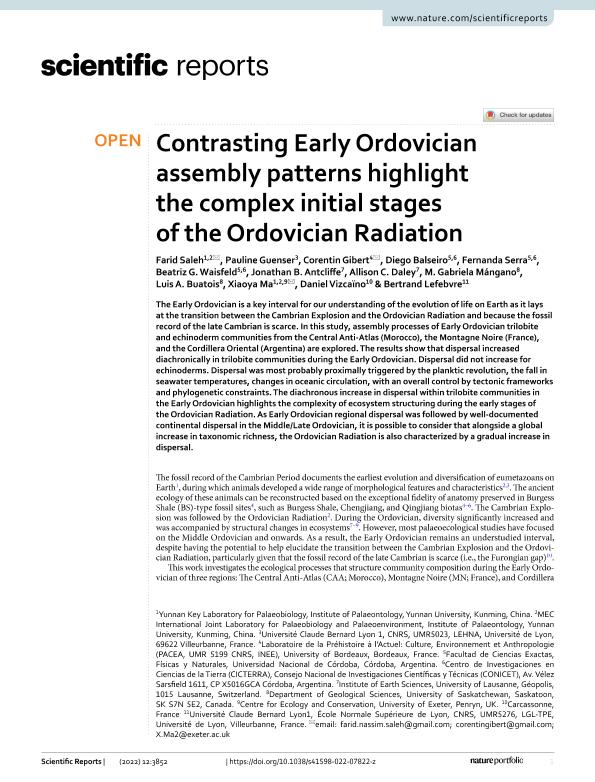Artículo
Contrasting Early Ordovician assembly patterns highlight the complex initial stages of the Ordovician Radiation
Saleh, Farid; Guenser, Pauline; Gibert, Corentin; Balseiro, Diego ; Serra, Fernanda
; Serra, Fernanda ; Waisfeld, Beatriz Graciela
; Waisfeld, Beatriz Graciela ; Antcliffe, Jonathan B.; Daley, Allison C.; Mángano, M. Gabriela; Buatois, Luis Alberto
; Antcliffe, Jonathan B.; Daley, Allison C.; Mángano, M. Gabriela; Buatois, Luis Alberto ; Ma, Xiaoya; Vizcaïno, Daniel; Lefebvre, Bertrand
; Ma, Xiaoya; Vizcaïno, Daniel; Lefebvre, Bertrand
 ; Serra, Fernanda
; Serra, Fernanda ; Waisfeld, Beatriz Graciela
; Waisfeld, Beatriz Graciela ; Antcliffe, Jonathan B.; Daley, Allison C.; Mángano, M. Gabriela; Buatois, Luis Alberto
; Antcliffe, Jonathan B.; Daley, Allison C.; Mángano, M. Gabriela; Buatois, Luis Alberto ; Ma, Xiaoya; Vizcaïno, Daniel; Lefebvre, Bertrand
; Ma, Xiaoya; Vizcaïno, Daniel; Lefebvre, Bertrand
Fecha de publicación:
03/2022
Editorial:
Nature Publishing Group
Revista:
Scientific Reports
e-ISSN:
2045-2322
Idioma:
Inglés
Tipo de recurso:
Artículo publicado
Clasificación temática:
Resumen
The Early Ordovician is a key interval for our understanding of the evolution of life on Earth as it lays at the transition between the Cambrian Explosion and the Ordovician Radiation and because the fossil record of the late Cambrian is scarce. In this study, assembly processes of Early Ordovician trilobite and echinoderm communities from the Central Anti-Atlas (Morocco), the Montagne Noire (France), and the Cordillera Oriental (Argentina) are explored. The results show that dispersal increased diachronically in trilobite communities during the Early Ordovician. Dispersal did not increase for echinoderms. Dispersal was most probably proximally triggered by the planktic revolution, the fall in seawater temperatures, changes in oceanic circulation, with an overall control by tectonic frameworks and phylogenetic constraints. The diachronous increase in dispersal within trilobite communities in the Early Ordovician highlights the complexity of ecosystem structuring during the early stages of the Ordovician Radiation. As Early Ordovician regional dispersal was followed by well-documented continental dispersal in the Middle/Late Ordovician, it is possible to consider that alongside a global increase in taxonomic richness, the Ordovician Radiation is also characterized by a gradual increase in dispersal.
Palabras clave:
Ordovician Radiation
,
Dispersion
,
niche
,
Community assembly
Archivos asociados
Licencia
Identificadores
Colecciones
Articulos(CICTERRA)
Articulos de CENTRO DE INVEST.EN CS.DE LA TIERRA
Articulos de CENTRO DE INVEST.EN CS.DE LA TIERRA
Citación
Saleh, Farid; Guenser, Pauline; Gibert, Corentin; Balseiro, Diego; Serra, Fernanda; et al.; Contrasting Early Ordovician assembly patterns highlight the complex initial stages of the Ordovician Radiation; Nature Publishing Group; Scientific Reports; 12; 1; 3-2022; 1-8
Compartir
Altmétricas



